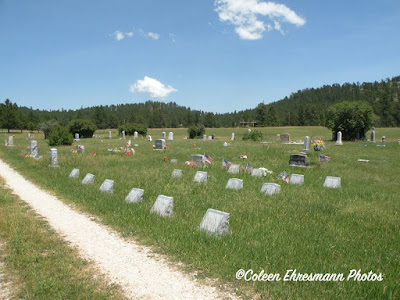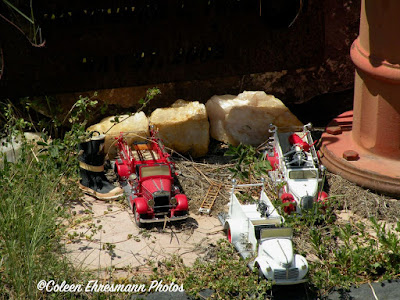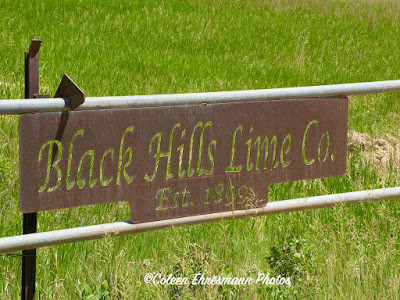No, I am not referring to the reconstituted potato chip in the tubular container but to a community in the Black Hills of South Dakota. Hubby and I had never been to the community before, but may have passed by when heading to the southern, southern part of the Black Hills region. Because of geocaching Pringle was a day's destination during our week of camping and caching.

I'm not certain how they got the distinction of Elk Capital of South Dakota. We didn't see any on our back roads travels.
"Pringle got its start as a stage stop on the Sidney-Custer Trail. Operated by Henry Pringle, it was called the Point of Rocks Stage Station, named after a prominent and distinct granite outcropping located due east of the current town.
The Sidney-Custer Trail was an important route into the southern Black Hills from Nebraska, and The Point of Rocks Station also served traffic between Cheyenne, Wyoming and Custer.
A small settlement, also called Point of Rocks, soon developed around the stage station. In 1890, the Chicago, Burlington, and Quincey Railroad track reached the settlement, at which time the town’s name was changed to Pringle, named after Anna Carr Pringle who provided hospitality to the railroad crews when they came through town. The settlement soon boasted a railroad depot and two stores." ~ Wikipedia
The stage stop building is still there, but I did not know that on my visit this week. Dang! There are two businesses in town, The Hitch Rail Bar & Restaurant and the post office, which started in 1885 as part of the stage stop.
Today, Pringle is a Trailhead for the Mickelson Trail, a 109 mile trail for biking, hiking, walking in the Black Hills. This monument was across the street from the trailhead shelter and bathrooms.
The Mickelson Trail was originally the Burlington Northern line that carried trains from Edgemont to the northern Black Hills and the gold mines of the Deadwood area. The trail transverses the beautiful Black Hills of South Dakota. The original track was built in in 9 months and 22 days, and was abandoned in 1983. A group of outdoor enthusiasts recognized the trail's potential, and with support of Governor George Mickelson, it became the state's first rails to trails project.
The trail has 15 trailheads, 100+ bridges (some of them the old railroad bridges), and 35 interpretive signs. The 109 miles connect Edgemont in the southern Hills region to Deadwood in the northern Hills.
The Pringle Volunteer Fire Department purchased this Soda and Acid Chemical Extinguisher in 1936. The bell at the top of the structure is from the Pringle School, which opened in 1914 and closed in 2001.
If we are geocaching, there must be a cemetery involved and there was.
quite the eagle carving in the dead tree trunk
this head stone caught my eye and deserved a closer look
most likely with the Pringle volunteer fire department
for many years
and highly respected
these ladies posed so quietly for me
established in 1899
"The plant at the Black Hills Lime Company at Pringle supplies most of the lime used in the gold mills of the Black Hills." ~ 1901 book on mining in the Black Hills
Lime mined in the Belle Fourche region was used in the refining of sugar beets.
the ore house and trestle
the two kilns for the lime mining operation
Although the buildings remain, I could not find information about if lime is still being mined from this quarry. I know for a fact it is an operational quarry as 3 dump trucks came down the road as I was parked taking photos. I did find the Kirk Quarry, now mining the Black Hills Lime Co. produces aggregate:
Aggregate is a broad classification of coarse to medium-grained rock material intended for use in construction.
This can include sand, gravel, crushed stone and mine waste, and rocks of all types can be mined or quarried for aggregate - making use of what is locally available for local construction rather than bringing higher quality rock from elsewhere at greater expense.
Aggregates are the most mined materials in the world.
green grass, green trees and blue sky
Without getting printed confirmation and based on our back roads travel and observations, I would say the land around Pringle is used for farming, ranching and logging.
Bike Park
(newest donations in the front to the left of the white path)
location of a geocache
not a small work of art
one of two 'covered' walk ways
the other covered walk way
Interesting to say the least!
Unfortunately, today Pringle is best known as the town closest to a 140-acre compound belonging to the Fundamentalist Church of Jesus Christ of Latter Day Saints (FDLS.) The “military-style” fortress, established in 2003, is surrounded by berms and barbwire and is continuously guarded by a lookout tower. The radical, polygamist offshoot of the Mormon Church is the same group that lived outside Eldorado, Texas when that compound was raided in 2008 over accusations of sex abuse and Warren Jeffs was sentenced to life in prison for child sex assault. The compound near Pringle was run for years by Seth Jeffs, a brother to Warren, who was convicted of harboring a fugitive for his role in helping Warren avoid arrest and later plead guilty to food-stamp fraud. Today, the compound is under scrutiny because the compound’s residents have never complied with a state law requiring them to report all births and deaths during the many years of its operation. The site has been a source of controversy in the area since its beginning, so much so, that a group of residents got together and purchased the property around it in an effort to stop the FLDS from expanding.
We did not come across the compound in our back roads meandering.
and 4 miles down the road...
the other side of the sign says Leaving the Black Hills
the beginning and the end
Needless to say, it was an interesting day in a unique little community...


















No comments:
Post a Comment
Thanks for your comments!